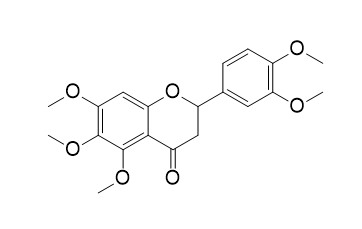5,6,7,3',4'-Pentamethoxyflavanone
5,6,7,3',4'-pentamethoxyflavanone exhibited anti-proliferative activities. 5,6,7,3',4'-Pentamethoxyflavanone inhibit PCSK9 mRNA expression with IC50 values of 21.4. 5,6,7,3',4'-pentamethoxyflavanone could also significantly inhibit NO production.
Inquire / Order:
manager@chemfaces.com
Technical Inquiries:
service@chemfaces.com
Tel:
+86-27-84237783
Fax:
+86-27-84254680
Address:
1 Building, No. 83, CheCheng Rd., Wuhan Economic and Technological Development Zone, Wuhan, Hubei 430056, PRC
Providing storage is as stated on the product vial and the vial is kept tightly sealed, the product can be stored for up to
24 months(2-8C).
Wherever possible, you should prepare and use solutions on the same day. However, if you need to make up stock solutions in advance, we recommend that you store the solution as aliquots in tightly sealed vials at -20C. Generally, these will be useable for up to two weeks. Before use, and prior to opening the vial we recommend that you allow your product to equilibrate to room temperature for at least 1 hour.
Need more advice on solubility, usage and handling? Please email to: service@chemfaces.com
The packaging of the product may have turned upside down during transportation, resulting in the natural compounds adhering to the neck or cap of the vial. take the vial out of its packaging and gently shake to let the compounds fall to the bottom of the vial. for liquid products, centrifuge at 200-500 RPM to gather the liquid at the bottom of the vial. try to avoid loss or contamination during handling.
Jour. of Stored Pro & Postharvest Res.2016, 7(3):32-36
Toxicol Appl Pharmacol.2022, 434:115815.
J.the Korean Socie. Food Sci.&Nut.2023; 52(1):26-39.
Int J Mol Sci.202, 25(17):9246.
Plant Pathology2022, 10.1111:ppa.13651.
Chemistry of Plant Raw Materials2022, 20220210569.
Antiviral Res.2013, 98(3):386-93
Phytomedicine.2018, 41:62-66
VNU J Science: Med.&Pharm. Sci.2023, 39(2):43-52.
J. Korean Wood Sci. Technol.2022, 50(5):338-352.
Related and Featured Products
Bioorg Chem . 2020 Jun;99:103869.
A stilbene dimer and flavonoids from the aerial parts of Chromolaena odorata with proprotein convertase subtilisin/kexin type 9 expression inhibitory activity[Pubmed:
32335358]
Investigation of components of the chloroform-soluble and ethyl acetate-soluble extracts of the aerial parts of Chromolaena odorata L. selected by PCSK9 mRNA expression monitoring assay in HepG2 cells led to the isolation of a new stilbene dimer, (+)-8b-epi-ampelopsin A (1), and 30 known compounds (2-31). The structures of the isolates were established by interpretation of NMR spectroscopic data and the stereochemistry of the new stilbene (1) was proposed based on ECD and NMR calculations. Among the isolates, 1, 5,6,7,4'-tetramethoxyflavanone (6), 5,6,7,3',4'-Pentamethoxyflavanone (7), acacetin (18), and uridine (21) were found to inhibit PCSK9 mRNA expression with IC50 values of 20.6, 21.4, 31.7, 15.0, and 13.7 μM, respectively. Furthermore, the most abundant isolate among the selected compounds, 6, suppressed PCSK9 and low-density lipoprotein receptor protein expression in addition to downregulating the mRNA expression of HNF-1α.
Nat Prod Res . 2021 Aug 5;1-6.
Synthesis and anti-proliferative activities of 5,6,7-trimethoxyflavones and their derivatives[Pubmed:
34353180]
A series of 5,6,7-trimethoxyflavones 1a-1g and their derivatives 2a-2g, 3a-3d, 4 and 5, including the natural products 5,6,7-trimethoxy-4'-hydroxyflavone (1a), 5,6,7,3',4' -pentamethoxyflavone (sinensetin, 1 b), 5,6,7-trimethoxy-3',4'-methyl enedioxy flavone (1c), 5,6,7,3'-tetramethoxy-4,5'-methylenedioxyflavone (1e), 5,6,7, 3',4',5'-hextamethoxyflavone (1 g), 5-hydroxy-3,4,2',3',4'-pentamethoxy chal-cone (2 b), 5,4'-dihydroxy-6,7-dimethoxy flavone (cirsimaritin, 3a) and 5-hydroxy-6,7,3', 4'-tetramethoxyflavone (5-demethylsinensetin, 3 b), 3,5,6,7,3',4'-hexamethoxyflavone (3-methoxysinensetin, 4) and 5'-hydroxy-3,6,7,3',4'-pentamethoxyflavone (5) were synthesized. Their anti-proliferative activity in vitro was evaluated against a panel of four human cancer cell lines (Aspc-1, HCT-116, HepG-2 and SUN-5) by the CTG assay. The results showed that most of the synthetic compounds exhibited moderate to high anti-proliferative activities. In particular, compound 3c possess IC50 (5.30 μM) values below 10 μM against Aspc-1 cells and are worthy of further investigation.
Food Chem . 2017 Nov 1;234:254-261.
Polymethoxyflavones in peel of Citrus reticulata 'Chachi' and their biological activities[Pubmed:
28551233]
Citrus polymethoxyflavones (PMFs) have been of increasing interest due to their extensive biological activities. In the present study, a total of eight PMFs were isolated from the peel of Citrus reticulata 'Chachi' (CRC). They were individually identified as 5-hydroxy-6,7,8,4'-tetramethoxyflavone (1), 5,6,7,3',4'-Pentamethoxyflavanone (2), 5-hydroxy-6,7,8,3',4'-pentamethoxyflavone (3), 3,5,6,7,8,3',4'- heptamethoxyflavone (4), 5,6,7,8,3',4'-hexamethoxyflavone (5), 5,6,7,8,4'-pentamethoxyflavone (6), 6,7,8,3',4'-pentamethoxyflavanone (7) and 5,6,7,3',4'-pentamethoxyflavone (8) by nuclear magnetic resonance and mass spectroscopic analysis. 6,7,8,3',4'-Pentamethoxyflavanone was isolated from the peel of CRC for the first time. The content of PMFs was firstly quantified in both the peel of CRC and PMF-rich extract by HPLC analysis. Furthermore, the biological activities of PMF compounds were investigated. 3,5,6,7,8,3',4'-Heptamethoxyflavone demonstrated potent sterol regulatory element-binding proteins inhibition activity and 5-hydroxy-6,7,8,3',4'-pentamethoxyflavone exhibited strong antiproliferative activity against tumor cell lines. The isolated PMF compounds could also significantly inhibit NO production and the effect varied mainly depending on the number of methoxy groups.



